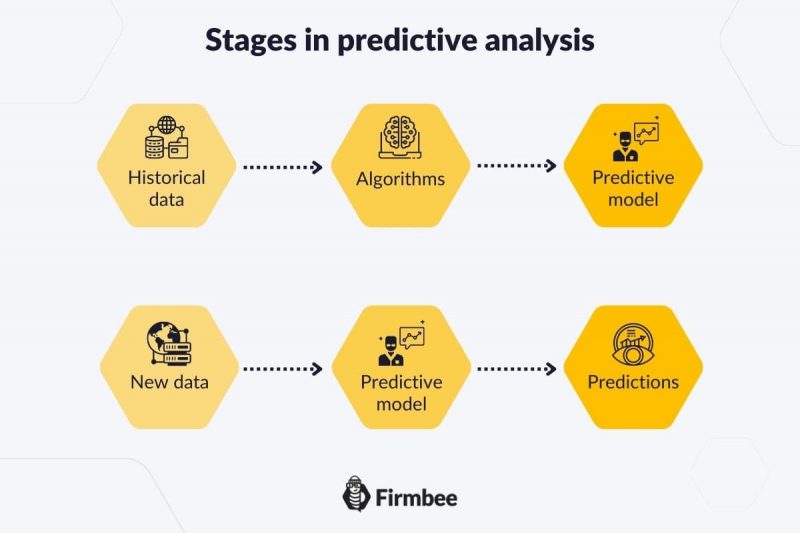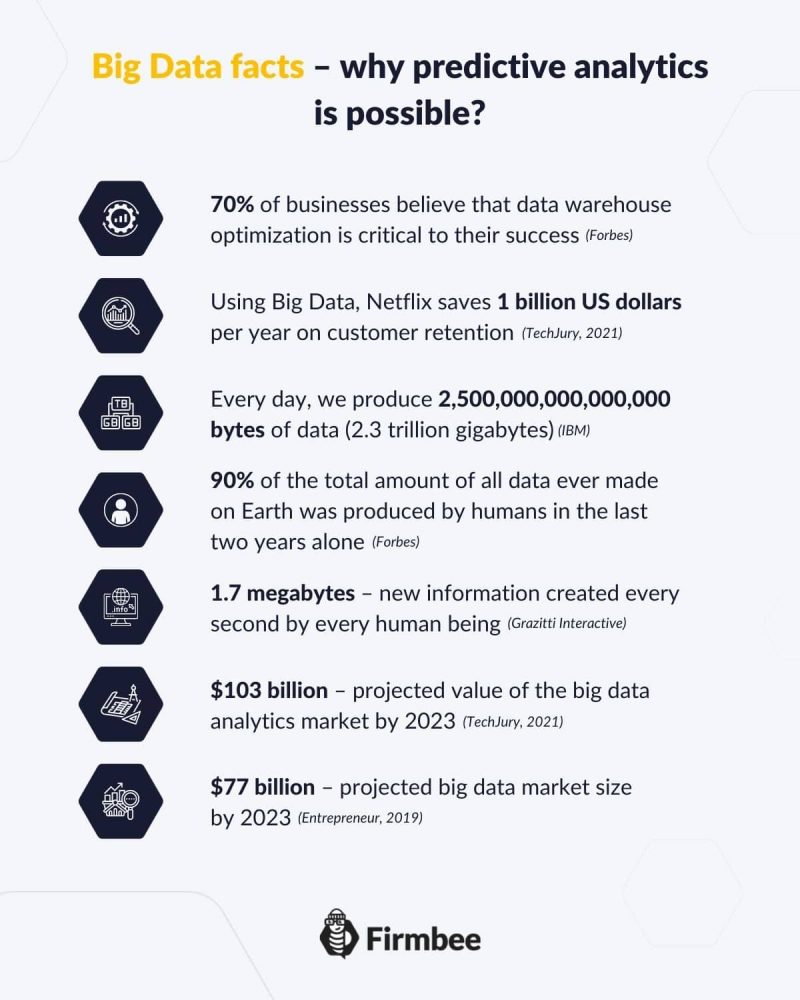What is predictive analytics? What are the five types of predictive analytics? What are the applications of predictive analytics across industries? Why more and more companies decide to use predictive analytics? Is this practice of examining data necessary for decision making and formulation of strategies? Read the article and find out more about current ways of predicting the future trends and events.
Predictive analytics – table of content:
- What is predictive analytics?
- 5 key types of data analytics
- Examples of application of predictive analytics
- Benefits of predictive analytics
What is predictive analytics?
Predictive analytics is also known as advanced analytics and used to predict what will happen next. All the research in predictive analytics is based on historical, already collected data sets, although the type of data used may vary. Currently it is no longer possible to process all the collected information using traditional techniques (like databases). The sets of data are immense and usually unstructured. All the hidden patterns we search for are not accessible at a first glance anymore and advanced, complicated techniques have to be used.
People are producing data constantly, Big Data is getting even bigger, and with this growth the techniques of analysis become more and more sophisticated. Still to produce any meaningful results the increased power of computers is crucial. Here, it is worth to remember, that the concept of predictive analytics has been around for several decades and only recently was able to show its usability.
Why not before? It is all due to the technological advancement of our societies – we have faster, cheaper computers, software is easy-to-use and finally ability to collect great volumes of data. As before the predictive analysis was a domain of interest of statisticians, mathematicians and scientists, than today business analyst or other experts may use predictive analytics with success.
5 key types of data analytics
We already know what is predictive analytics, but what types of analytics are there? There are five types of analytics, which can be used by your business all methods are strongly connected through various detailed techniques and generally are seen as steps in predictive analysis. Five types of analytics include:
Descriptive Analytics – the most common and broadly used type of analytics, that analyses the data coming in real-time, information is taken from social media and web-sites. Financial and sales reports are the most known examples of descriptive analytics.
Diagnostic Analytics – the second most known type of analytics, which deals with reasons or factors, which affect different happenings in the business.
Predictive Analytics – this type of analytics deals with forecasting, where the analyst tries to predict what may happened next based on all previous patterns or trends.
Prescriptive Analytics – is another step after the other types of analytics, which helps create prescriptions to solve problems, it uses data derived from the results of the other types of analytics. One of the examples of the prescriptive analysis is Google Maps application, which is able to help to choose the best route based on data related with: distance, traffic, and speed.
Cognitive Analytics – it combines altogether several different analytics forms such as: semantics, artificial intelligence, machine learning algorithms, deep learning models, all this allowing a cognitive application of the software used to improve over time. To derive any conclusions large sets of structured and unstructured data are being analyzed.

Examples of application of predictive analytics
Predictive analytics is used by the industries of the highest importance, where the assessment of the risk and prevention of unexpected events is crucial. There are many industries, who use methods of predictive analysis and it is not possible to enlist them all since the field is rapidly developing. It is worth to mention such industries like:
Automotive – autonomous vehicles or vehicles with driver assistance technology apply predictive analytics to create better driver assistance algorithms.
Financial services – all types of analytics are used to predict risk related to credit or future cash flows. All sorts of financial factors can be predicted such as: sales, revenues or expenses. Historical data from all financial statements cab be used for projections. Here quantitative tools and machine learning techniques are being used..
Energy industry – energy production requires high level of monitoring of different type of data such as: the weather conditions, seasonal changes, plant availability, demand and power consumption, all to predict electricity price and consumption.
Manufacturing – in the industries such as aviation or machinery production predictions are being made regarding failures that can occur in the machine or aircraft engine parts. Analytics aim to forecast the health of machine elements, and that help to reduce the cost and time of maintenance and repair. Malfunctions have to be prevented also to stop harmful, risky, dangerous situations from occurring. Damages made by malfunctioning devices can cost millions in cash due to costly repairs as well as due to legal fees in case of lawsuits and security claims.
Medicine and health care – highly technical medical devices use all types of algorithms at different stages of diagnostic procedures. The care industry invests millions in wearable smart devices that can be used by patients to collect medical data – all the devices use some type of of predictive analytics algorithms to detect and forecast bodily reactions, their strength and possible need for injection of drugs or medications.
Hospitality – large hospitality companies which posses hotel chains or chains of restaurants cannot rely on simple prognoses, the bigger the company the greater need for detailed, accurate forecasting. Hospitality operators need to determine staffing needs, flow of customers to avoid costly overstaffing or detrimental understaffing.
Marketing – since there is plenty of data related to consumers behavior the usage of predictive analytics is the obvious step to be made. Better advertisement with carefully adjusted content as well as great strategies can be a result of predictive analytics, which can increase likelihood of purchasing decisions. Additionally, the predictive analytics may be used in such situations as: identification of customers that a likely to stop using a service or for improvement of customer service.

Benefits of predictive analytics
There are various benefits to using predictive analytics but the main one is the ability to make predictions in difficult situations where no direct, clear data is available. The forecast can be drawn upon information taken from many sources and even facts, which seem not to be directly connected to our problem may be of value.
Business leaders, researchers, scientist and investors can use predictive analytics to reduce risk of all sorts of operations. Each time the risk is identified and mitigated the control over capital and earnings are being protected. Even small occurrences may impact the business and bring unforeseen threats, that can bring catastrophic results in the long run.

Summary
Regardless of the industry predictive analytics can be used to produce deeper insight into any complicated process as long as the related data is available. Predictive analytics enables leaders to make sound decisions that can not only increase sales figures, change marking strategies, prevent costly malfunctions or assess staffing needs but save lives, prevent disasters and help to avoid occurrences of unnecessary tragic event as well. Without knowing, what is predictive analytics contemporary business would not be the same.
Read also: What is a CEO?
If you like our content, join our busy bees community on Facebook, Twitter, LinkedIn, Instagram, YouTube.
Author: Andy Nichols
A problem solver with 5 different degrees and endless reserves of motivation. This makes him a perfect Business Owner & Manager. When searching for employees and partners, openness and curiosity of the world are qualities he values the most.


















